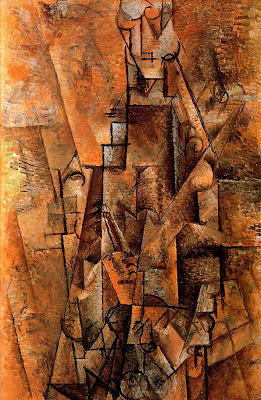







Via Wikipedia
"Cubism was a 20th century avant-garde art movement, pioneered by Pablo Picasso and Georges Braque, that revolutionized European painting and sculpture, and inspired related movements in music, literature and architecture. In cubist artworks, objects are broken up, analyzed, and re-assembled in an abstracted form—instead of depicting objects from one viewpoint, the artist depicts the subject from a multitude of viewpoints to represent the subject in a greater context. Often the surfaces intersect at seemingly random angles, removing a coherent sense of depth. The background and object planes interpenetrate one another to create the shallow ambiguous space, one of cubism's distinct characteristics.
Historians have sought to analyze the history of cubism in terms of phases. In one scheme, a first branch of cubism, known as Analytic Cubism, was both radical and influential as a short but highly significant art movement between 1907 and 1911 in France. In a second phase, Synthetic Cubism, the movement spread and remained vital until around 1919, when the Surrealist movement gained popularity. English art historian Douglas Cooper proposed another scheme, describing three phases of Cubism in his seminal book, The Cubist Epoch. According to Cooper there was "Early Cubism", (from 1906 to 1908) when the movement was initially developed in the studios of Picasso and Braque; the second phase being called "High Cubism", (from 1909 to 1914) during which time Juan Gris emerged as an important exponent; and finally Cooper referred to "Late Cubism" (from 1914 to 1921) as the last phase of Cubism as a radical avant-garde movement.[2]"
"Analytic Cubism: The invention of Cubism was a joint effort between Pablo Picasso and Braque, then residents of Montmartre, Paris. These artists were the movement's main innovators. A later active participant was Juan Gris. After meeting in 1907 Braque and Picasso in particular began working on the development of Cubism. Picasso was initially the force and influence that persuaded Braque by 1908 to move away from Fauvism. The two artists began working closely together in late 1908–early 1909 until the outbreak of World War I in 1914. The movement spread quickly throughout Paris and Europe.
French art critic Louis Vauxcelles first used the term "cubism", or "bizarre cubiques", in 1908 after seeing a picture by Braque. He described it as "full of little cubes", after which the term quickly gained wide use although the two creators did not initially adopt it. Art historian Ernst Gombrich described cubism as "the most radical attempt to stamp out ambiguity and to enforce one reading of the picture—that of a man-made construction, a coloured canvas."[4]
Cubism was taken up by many artists in Montparnasse and promoted by art dealer Daniel-Henry Kahnweiler, becoming popular so quickly that by 1911 critics were referring to a "cubist school" of artists.[5] However, many of the artists who thought of themselves as cubists went in directions quite different from Braque and Picasso. The Puteaux Group or Section d'Or was a significant offshoot of the Cubist movement; it included Guillaume Apollinaire, Robert Delaunay, Marcel Duchamp, his brothers Raymond Duchamp-Villon and Jacques Villon, and Fernand Léger, and Francis Picabia. Other important artists associated with cubism include: Albert Gleizes, Jean Metzinger,[6] Marie Laurencin, Max Weber, Diego Rivera, Marie Vorobieff, Louis Marcoussis, Jeanne Rij-Rousseau, Roger de La Fresnaye, Henri Le Fauconnier, Alexander Archipenko, František Kupka, Amédée Ozenfant, Jean Marchand, Léopold Survage, Patrick Henry Bruce among others. Section d'Or is basically just another name for many of the artists associated with cubism and orphism (or "Orphic Cubism"). Purism was an artistic offshoot of Cubism that developed after World War I. Leading proponents of Purism include Le Corbusier, Amédée Ozenfant, and Fernand Léger.
Cubism and modern European art was introduced into the United States at the now legendary 1913 Armory Show in New York City, which then traveled to Chicago. In the Armory show Jacques Villon exhibited seven important and large drypoints, his brother Marcel Duchamp shocked the American public with his painting Nude Descending a Staircase, No. 2 (1912) and Georges Braque, Pablo Picasso, Fernand Léger, Raymond Duchamp-Villon, Roger de La Fresnaye, Marie Laurencin, Albert Gleizes, and other cubist painters contributed examples of their cubist works. Braque and Picasso themselves went through several distinct phases before 1920, and some of these works had been seen in New York prior to the Armory Show, at Alfred Stieglitz's "291" gallery. Czech artists who realized the epochal significance of cubism of Picasso and Braque attempted to extract its components for their own work in all branches of artistic creativity—especially painting and architecture. This developed into Czech Cubism which was an avant-garde art movement of Czech proponents of cubism active mostly in Prague from 1910 to 1914."
